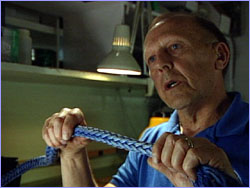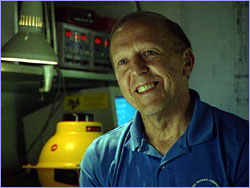
|
 |
 Hear Le Olson via RealAudio: 28.8 | isdn software |
 Meet the Team:
Meet the Team:LeRoy Olson LeRoy Olson, known to everyone simply as Le, is a Principal Mechanical Engineer at the Applied Physics Laboratory, University of Washington. He has been involved in ocean engineering projects since 1960. Olson is chief engineer of the project to try to lift a black smoker chimney off the Juan de Fuca Ridge, a daunting technical feat that he talks about candidly in this interview. NOVA: What did you think of John Delaney's idea when you first heard it? Olson: Well, he came to me and said he wanted to recover something 20 feet tall and 10 feet in diameter, and I said you're kidding, it'll be too heavy, probably 120,000 pounds or something. So the first thing I had to do was scale him down in size. I said, research vessels normally work with maybe 20,000 pounds on their A-frame, and winches and lines are in that ballpark. So, if he could go with that, I'd be able to try it. NOVA: You're going to be working on something 8,000 feet down in the sea. What would someone have to do on land to get a sense of that? Olson: Well, I suppose if that person has flown at night over Mt. Rainier with an 8,000-foot line and tried to set something on the top, they might have the feeling of the difficulty. They would have the advantage of having seen it in the daylight, so they would know what they're setting it on. That's hard in the ocean. Normally the pictures we get are maybe six feet square and 30 feet away. You don't see the overall picture like you would in air. It's hard for people to appreciate that aspect, I think. It's also hard for them to appreciate the pressure. At 7,000 feet, it's perhaps 3,500 pounds of pressure on every square inch. Think of a small automobile sitting on a postage stamp. The animals down there are all full of fluid, so they're pressure-balanced and it's not a problem. But anytime you put a void down, with electronics in it, say, the ocean's trying to crush it. Finally, you could put them on a roller coaster and have them do it at the same time, because ships don't sit still at sea. At sea you get done about one-fourth of the work you do in the lab, because if you're not on some kind of medication to slow your system down, your body automatically does it only after a while. You may not be vomiting over the rail, but it's hard to think, and it's even hard to force yourself to think at times. This is hard for people to realize, unless they've been out on a small boat and been sick a few times. NOVA: So what's your plan for the recovery?
We've also got to get the recovery sling down, or the cage that has the slings in it. We may free-fall it from the surface. We'll put a weight on it and attach the cage and then some floats and a transponder. [The transponder will be used to locate the cage once it comes to rest on the bottom, and the float will be used to bring the cage back to the surface.] Then, when we know where it is down there, ROPOS, the remotely operated vehicle, can go over and pick it up and carry it over to the structure. ROPOS will grab the cage, put it onto the structure, and tighten it up so that we're ready for recovery. ROPOS will then have to come back to the surface to get the chain saw. It'll be mounted on the vehicle, then ROPOS will go back down to the chimney and begin sawing. You come in and cut one place, then you come over here and cut it, probably not at the same level. So we'll have some multiple cuts around, to weaken the plane. Our greatest fear is that we won't get enough cut, so that when we hook the line onto it, we can't pull it loose. When ROPOS is finished cutting, it will go over to the line basket and get the hook that is on the outside of the line to the surface, carry it over and snap it into the lift bridle. At that point, ROPOS will go back to the ship. Then we'll acoustically release the line floats that carry this line to the surface. We've got about 200 pounds of buoyancy on this line to get it up through the water column. When the line gets to the surface, we'll pick it up with a small boat and bring it over to the recovery ship. The line will be strung on the winch, and we'll take a load on it. At that point we'll break the chimney loose. NOVA: What will happen if the chimney doesn't break free? |
||
|
Hear Le Olson via RealAudio: 28.8 | isdn |
 Olson: If it doesn't break loose, you'll have a ship at
sea anchored to a rock on the bottom with a very strong line.
We would build another acoustic release that has a cutter on
it, and if we really pull on the chimney and can't get it
loose, we would slide this release down to the cage and
acoustically activate it so that the high-pressure seawater
will sever the line, and we'll be free of the bottom. Then
we'll start all over again.
Olson: If it doesn't break loose, you'll have a ship at
sea anchored to a rock on the bottom with a very strong line.
We would build another acoustic release that has a cutter on
it, and if we really pull on the chimney and can't get it
loose, we would slide this release down to the cage and
acoustically activate it so that the high-pressure seawater
will sever the line, and we'll be free of the bottom. Then
we'll start all over again.NOVA: Assuming you get the chimney to the surface, is it a challenge to get it on board the ship? Olson: When you bring something up that's nine tons, say, and have it at the fantail—well, think of a wrecking ball. You're trying to control it and get it onto the ship and secure it. The real tense part is going to be from getting it at the water interface onto the deck, and that's about a nine-foot rise. And if it gets away from you there, it can do real damage. The main thing is to keep people away from being stuck between a solid object and this swinging thing. We've done this kind of operation before, and in 38 years of going to sea, I've never hurt anybody yet. Safety is our prime concern. The big thing is that when you put a line like this on the seafloor, it may abrade on something down there, and you don't know it. And when it comes up to the air/sea interface, the part that has been down by the structures abrading is the thing that's going to hold it when it's coming up through the air, and that's when the load is the heaviest, because in water, it's displacing seawater, so it's not as heavy. NOVA: What would be the worst-case scenario? Olson: Well, as it came out in the air and got heavy, you'd see it fall back to the seafloor. That'd be sickening. Actually, my greatest fear is hurting or killing somebody, and it's a very strong potential if you get this rock swinging on the deck. That's really my worry, just keep people out of the way of it and yet control the thing so it doesn't beat up the ship, too. NOVA: How will you feel when you see one of these towers on deck?  Olson: We're laying awake nights now thinking about all
the things that can go wrong, so at least we'll get a good
night's sleep. It's just like winning a ball game or anything
else: you go out there with a goal and if you don't accomplish
the goal, it's not very rewarding. We engineers have a real
responsibility to the museum and to the scientists, and that's
a lot of pressure on us to perform. A scientist can go out and
observe something and come back with all kinds of information,
and he's succeeded. An engineer goes out with a goal to bring
something back, and if it he doesn't bring it back, he hasn't
succeeded. I think that gives you some feeling for how we're
going to feel.
Olson: We're laying awake nights now thinking about all
the things that can go wrong, so at least we'll get a good
night's sleep. It's just like winning a ball game or anything
else: you go out there with a goal and if you don't accomplish
the goal, it's not very rewarding. We engineers have a real
responsibility to the museum and to the scientists, and that's
a lot of pressure on us to perform. A scientist can go out and
observe something and come back with all kinds of information,
and he's succeeded. An engineer goes out with a goal to bring
something back, and if it he doesn't bring it back, he hasn't
succeeded. I think that gives you some feeling for how we're
going to feel.NOVA: How is it to work with a visionary like John Delaney? |
|||
|
Hear Le Olson via RealAudio: 28.8 | isdn |
Olson: It's a tremendous thing. I mean, if we had to
work with engineers all the time it'd be awful dull work. We
like to control our environment so much that we don't want to
step beyond. You have to have scientists that really push.
That's part of the reason I've worked here for 38 years: I've
worked with scientists who are breaking the sound barriers,
essentially, in the ocean. Without that, we'd probably be
doing other things.
Interviews: Delaney | Kelley | Mathez | Olson | Shepherd Birth of an Expedition | Mission Plan | Dispatches Through the Porthole | Meet the Team Meet ROPOS (JavaScript/Frames-capable browser required) Meet ROPOS (No Frames/JavaScript) The Mission | Life in the Abyss | The Last Frontier | Dispatches E-mail | Resources | Table of Contents | Abyss Home Editor's Picks | Previous Sites | Join Us/E-mail | TV/Web Schedule About NOVA | Teachers | Site Map | Shop | Jobs | Search | To print PBS Online | NOVA Online | WGBH © | Updated October 2000 |
